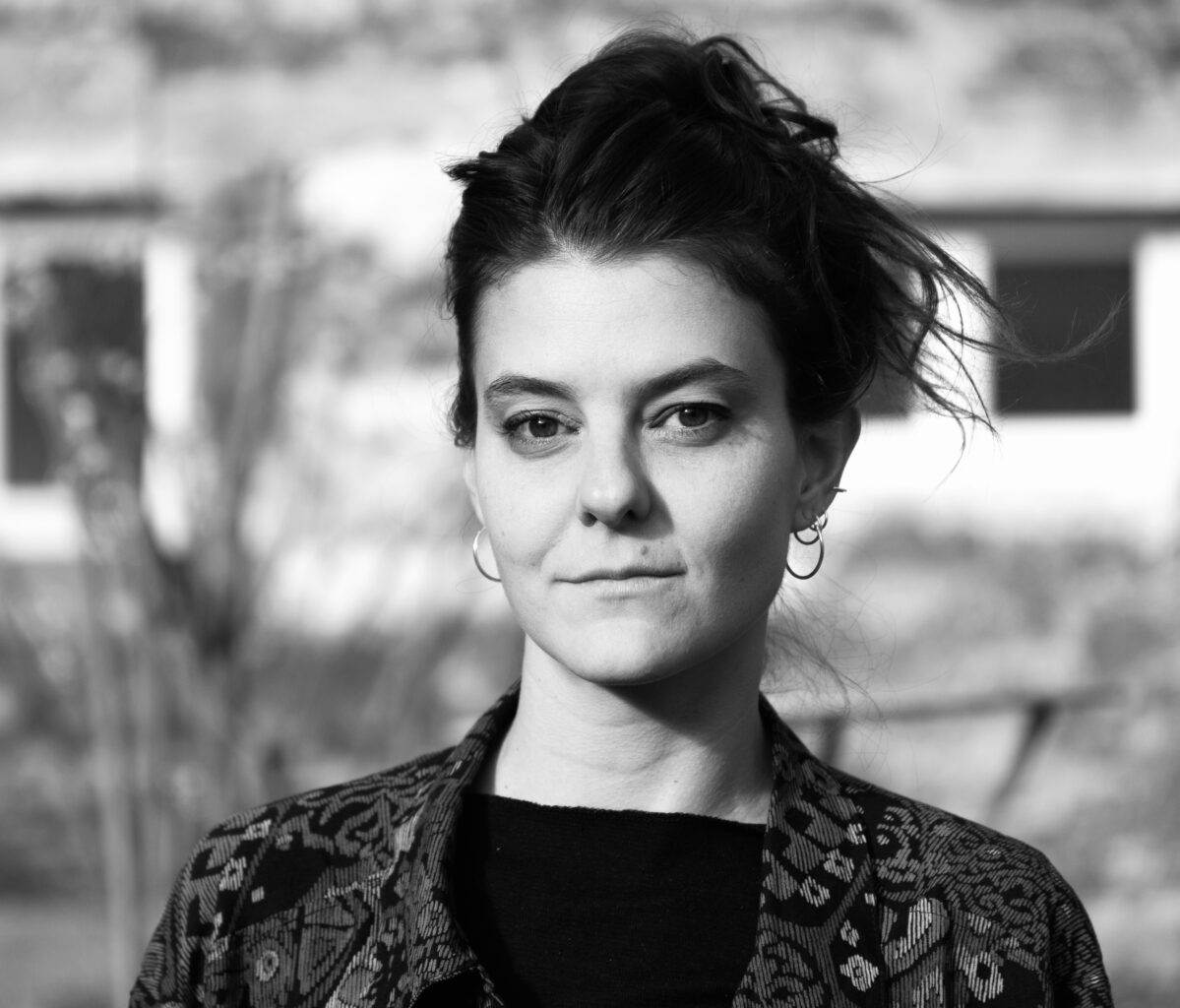
Lucia, could you tell us about the background and starting point of your performance, how did you research and work on the movement material?
The starting point of the research was the concept of ‘reverb’ –phenomenon of resonance by which sound, striking the surfaces of the space where it is emitted, is modulated by adopting the qualities of that space– and trying to build a parallelism with what I was experiencing as a foreigner in Europe.
Taking this concept as inspiration, I developed two lines of exploration. One, more rooted in working with the materiality of sound itself: sound frequencies and deformations of recordings of my own body sounds; where I tried to establish a link between sound vibration and possible kinetic responses to these stimuli. The other, taking the concept of reverb as a metaphor for distortion: the symbolic side of the phenomenon of resonance; where I worked on a sequence of movements based on a series of gestural images taken from my personal history in Argentina, digging into them, deconstructing them and letting them transform.
The voice work is also an important choreographic element of the piece. It wasn’t just external sound that interested me, but also internal sound: the body as the first resonant architecture, and at the same time as a sound transmitter. A sound that in turn modulates itself with the space present. An inverted body. A person from the south living in the north. This last step awakened the concept of Mother Tongue, bringing to the fore the idea of memory, origins, learning, copying and adaptation.
Voice and movement were nourished by these ideas, using transformation and affectation as a composition tool.
I am curious to hear more from you about what happens to one’s body and persona when leaving one’s own country– when leaning into and inhabiting another language?
My first survival response was to find similarities with what I knew and what I was discovering. The ‘sponge mode’ was on and everything that I could recognise as similar was at the same time transversally different. While trying to get involved with a new context, my body was also re-affirming its roots. This operation was more related to my visual experience.
Regarding sound, I think the process was different. Learning to speak a new language is super challenging and almost ridiculous. You have to constantly put yourself in a performance mode where you do ‘as if’ you knew how. Laughing about myself was a saving strategy to cope with this.
Visual and sound experiences were reunited in my body, in my sensorial experience, in the relation with touch and proximity. It’s beautiful the way you propose the language: “as a place to inhabit”. I feel it that way. A new place that opens inside yourself, that makes you discover new parts of your personality (because learning a language is also getting into the skin of a culture, its dynamics, its humour and its ways of processing the world). So while learning this new way of communication I was also discovering new possibilities of being.
In that way, I think speaking a language that is not your mother tongue can open a poetic space – one that is extremely personal, born from the mixture and the complexity of imperfect translations.
Mother Tongue is your first work as a choreographer – a solo you created for yourself. How does this first step as choreographer relate to your work as a dancer in other artists’ performances?
While I was living in Argentina, I co-directed a dance collective called La Montón, with which we created pieces in a horizontal way. Decisions and inspirations were shared. Mother Tongue is my first piece in Europe as a choreographer, without the safety net of sharing responsibilities. At the same time, I feel that putting myself in that challenge enabled me to discover my own desires and fantasies, to get seduced profoundly with what was troubling me and inspiring me. And I confess it is a no way back path.
Performing for other artists is something that I enjoy doing a lot. Being able to give body and feelings to other’s imagination works for me as a displacement move that nourishes my practice. And I am so grateful of having these experiences! What I can admit that changed since I faced the creation of Mother Tongue is my affirmation towards these collaborations. I started to have the sensation that my voice was beneath theirs. I understand now differently the way I can engage and collaborate in other choreographer’s processes.
Lucía García Pullés: Mother Tongue
Caisa 11.11.2025 18.00 / 12.11.2025 21.00
Soup Talk 12.11.2025 12.00 @Caisa
Choreography and interpretation: Lucía García Pullés
Sound creation: Aria Seashell Delacelle
Song: Mailén Pankonin
Costume: Anna Carraud
Light creation: Carolina Oliveira
Stage manager on tour: Marie Predour
Vocal coach: Daniel Wendler
External eye: Marcos Arriola
Artistic collaboration: Sophie Demeyer, Volmir Cordeiro
Production: Bureau Cokot – Julie Le Gall
Co-production: MC93 – Maison de la Culture de Seine-Saint- Denis (FR) and Riksteatern (SE), as part of Common Stories, a Creative Europe programme financed by the European Union – Charleroi Danse (BE) – La Manufacture CDCN Nouvelle Aquitaine Bordeaux, La Rochelle – Théatre de Vanves (FR) – Support of the DRAC Ile-de-France au titre de l’aide au projet
Supported by: La Ménagerie de Verre (FR), Carreau du Temple (FR), Danse Dense (FR), Centre National de la Danse (FR), La Compagnie DCA à Saint-Denis, Festival Solos al Mediodía, Théâtre Solis (UR)
Mother Tongue premiered in Festival Artdanthé, Vanves in March 2025.
Photo: Oscar Chevillard
Visit in collaboration: Caisa
